 |
||||||||||||||||||
| Producing Woodlands & Prairies Magazine is a team effort. I’d like you to meet the people behind the bylines and the names on the masthead. | 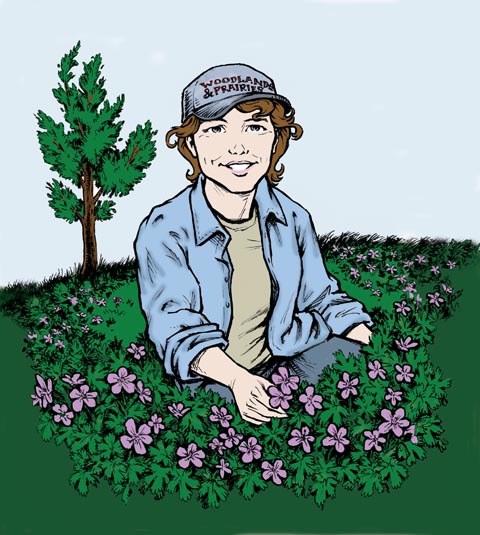 |
|||||||||||||||||
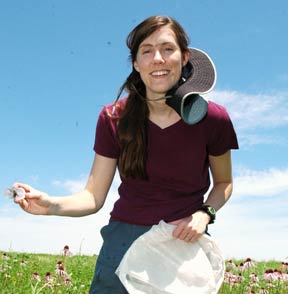 |
||||||||||||||||||
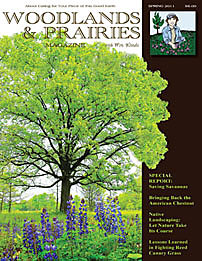 |
||||||||||||||||||
| Jennifer L. Hopwood: Our bug lady
While a biology student at the University of Kansas, Jennifer tells us she was astonished to learn how little was known about insects. That’s when she got serious about studying and defending these misunderstood and underappreciated members of the animal world. She went on to get a master’s degree in entomology at KU and then worked as a research assistant in entomology labs at both KU and Iowa State University. Jennifer hopes to find similar work in St. Louis, where her husband, Tim, recently took a position as a research scientist in plant ecology at Washington University. Meanwhile, as the magazine’s Bug Lady she’ll continue to explain the importance of native insects and why we should maintain their habitat. “We’d starve to death if we didn’t have them as pollinators,” she says. Click here to see Jennifer’s story for the magazine from the Winter 09 issue. |
||||||||||||||||||
| Jack Knight: Our tree guy
Jack Knight hates to see land cleared of trees. He tells how as a kid growing up in northeastern Iowa he used to explore the forests in the hills along the Yellow River. Then he’d return to find some areas logged off. That experience planted a seed that grew into an obsession about trees. In 1975, as a young college student, Jack bought 80 acres in those hills. About half had been logged for pasture. He had no tools; he didn’t even own a car. With just $200 in his pocket, he convinced a benefactor to back him. He’s reforested the land over the years, planting thousands of trees, mostly species of the original oak-hickory forest ecosystem, plus some conifers. Jack insists the trees are air conditioning the hills by storing water and pumping out oxygen. Who are we to disagree? Jack’s insatiable curiosity about trees has led him devote a piece of his land to tree nursery where he’s planted everything from catalpa to persimmons, and from peaches to pecans just to see what would grow. When not planting trees on his own land, Jack has supported himself as a professional tree planter. Swinging a hoe dad, he’s planted trees everywhere from the piney woods in the Deep South to the conifer forests of the Upper Midwest. Now 55, Jack says his goal is to have planted two million trees before he hangs up his hoe dad. Click here to see one of Jack’s stories as our Tree Guy from the Spring 08 issue. And here’s a story from the Winter 06 issue about Jack’s life as a professional tree planter. |
||||||||||||||||||
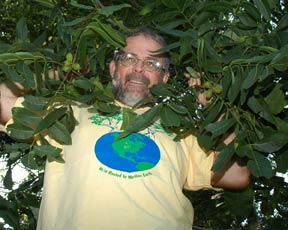 |
||||||||||||||||||
| Dan Bohlin: Our invasive species guy
In late 1997 Dan Bohlin had wrapped up a 30-year career with the US Air Force and was looking forward to restoring the old dairy farm his parents had purchased years ago as a retreat for their own retirement. The 260-acre farm of mixed woodlands, CRP and hay ground lay in the hills of southwestern Wisconsin near the village of Stitzer. Dan had visions of returning the land to its pre-settlement condition of prairies and oak savannas---while having the place pay for itself. Then came the reality check. After years of neglect, Dan found that a notorious gang of invasive species had taken over the farm, notably buckthorn, honeysuckle, garlic mustard and multiflora rose. “The understory in much of the timber was almost solid buckthorn,” Dan says. The buckthorn had to be dealt with if he was ever to realize his hopes for the farm. Dan learned all that he could about buckthorn and its control, and then he contributed new insights fighting buckthorn on his own farm. Through the years he’s become a respected authority on controlling buckthorn and other invasive species. You ought to see what he’s done on his own farm! It’s a showcase of what’s possible. In our pages Dan preaches what he practices as the Invasive Species Guy. “Don’t give up,” he tells us.“Over the past six years, I’ve slain monster buckthorn and am restoring the health of my oak savanna.” Read the full story of Dan’s battle with buckthorn from the Fall 2007 issue. |
||||||||||||||||||
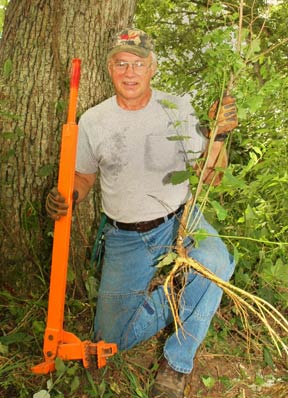 |
||||||||||||||||||
| Carl Kurtz: Our nature watcher
Carl Kurtz got hooked on nature photography as a sophomore in high school when he took a folding Kodak camera with him on an FFA trip to Colorado. He’s been sharing his views of the natural world ever since. I think you’ll agree that his artful photography and writings add to our appreciation and understanding of nature. When not interpreting nature, Carl and his wife, Linda, are nurturing it on their 172-acre farm in central Iowa near the village of St. Anthony. They’ve restored much of the farm to tallgrass prairie, and from it they harvest and sell prairie seed. Carl's books include "Iowa's Wild Places", published by Iowa State University Press, and "A Practical Guide to Prairie Reconstruction", published by the University of Iowa Press. He has also taught natural history photography. He graduated from Iowa State University with a degree in fisheries and wildlife biology. Hundreds of his photographs have been published in books, magazines and calendars. In our magazine he helps us see nature in new and beautiful ways through the regular feature, "Naturalist's Notebook". Click here to see his Naturalist's Notebook feature from our Summer 2006 issue. |
||||||||||||||||||
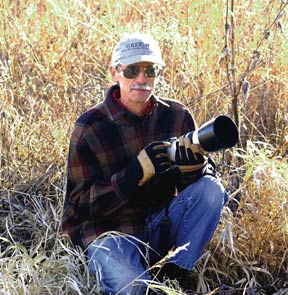 |
||||||||||||||||||
| Alice D’Alessio: A way with words
Alice D’Alessio doesn’t use a camera. She uses words to paint pictures of the world around us through her poetry and essays. Her poems have appeared in several magazines, and a book of her poetry, "A Blessing of Trees", published by Cross+Roads Press, came out in 2004. In ways that stir our souls, many of her poems relate to experiences that we’ve had in caring for a piece of land. The land Alice cares for lies in a valley just north of Ridgeway on the eastern edge of the Driftless Area in southwestern Wisconsin. Its 120 acres contain a wonderland of native ecosystems, with oak and pine woodlands on the ridges falling away to prairies and then a wetland. Alice says there’s so much to do there that it’s hard to find time to write. We’re happy she finds time to write for us. In addition to poems, essays and feature stories, Alice writes many of the book reviews for the magazine. She grew up on the East Coast and once worked as an assistant editor for Esquire magazine before moving west and finding her muse in the hills of Wisconsin. Two of her poems appeared in the Summer 2005 issue. Click here to view them. |
||||||||||||||||||
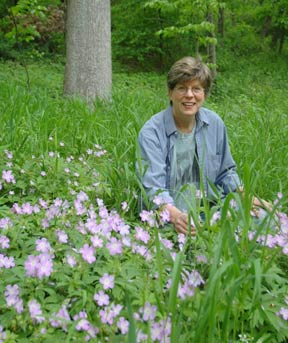 |
||||||||||||||||||
| Brenda Boddicker: Our designing lady
Working her magic on a Mac computer, Brenda makes all of us look good as the graphic designer for the magazine. But Brenda knows another world. After graduating with a degree in graphic design, she broke into design work in the pre-digital era without the benefit of computer programs. “We did a lot of hand work in the days before computers,” she says. “You had to be more of an artist and more disciplined. The experience made me a better designer.” Brenda also learned the printing process from top to bottom working for various newspapers and print shops in eastern Iowa---another good experience for a designer, she says. Today Brenda works for Howe Printing Company in Prairie du Chien, Wis., www.howeprinting.com. The company also prints our magazine. Brenda says that everyone in the shop takes special pride in producing Woodlands & Prairies Magazine---from the pressman to the people who work in the bindery. In addition to the high-quality printing job, you have to admit that the magazine has a special look with its clean, uncluttered design and storytelling photographs. People tell us the magazine is not only beautiful but easy to read, in addition to being informative. And readers seem to appreciate that there are no ad pages to get in the way. Brenda says she and editor Rollie Henkes developed the magazine’s “look” over the years through give-and-take. Rollie, who is kind of conservative, digs in his heels against designs he thinks are too wild, while Brenda keeps the magazine from looking too dull. |
||||||||||||||||||
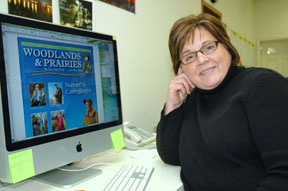 |
||||||||||||||||||
| Our born-again editor
When he's not off someplace gathering stories, you'll find our editor, Rollie Henkes, in his home overlooking the Yellow River Valley in northeastern Iowa. His rugged, mostly wooded 80 acres cry for attention, but Rollie is most likely to be hunched over his computer. And I must say for someone who interviews other people all of the time, he’s not very forthcoming when he’s the interviewee. He does share that he’s a widower with a bunch of grandchildren whom he doesn’t see as much as he like. He also says that he didn’t set out to publish a magazine when retired here a few years ago. The magazine found him. And now he’s on this mission to tell the stories of the people who are saving the planet bit by bit at the grass roots. He was a farm magazine writer before this. He says like most in mainstream agriculture, he was blissfully unaware of native ecosystems and their worth. But no more. “I saw the light, and now I want everyone to,” he says. Rollie writes occasional essays for the magazine when he has “something to write about.” Here’s his piece from the Spring 2008 issue about his confrontation with a wayward elk. |
||||||||||||||||||
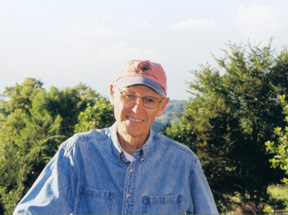 |
||||||||||||||||||
|
|
||||||||||||||||||
|
Midwest Woodlands & Prairies is published four times a year by Wood River Communications.
© by Wood River Communications. Reproduction prohibited without written consent. |
||||||||||||||||||